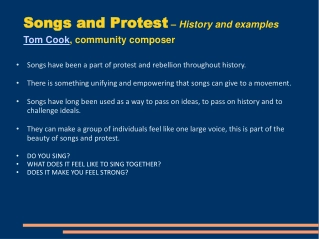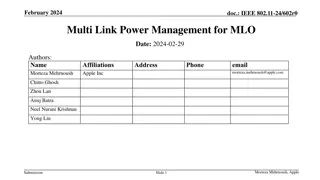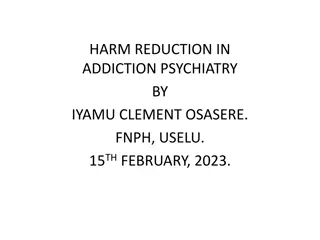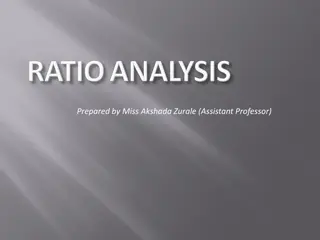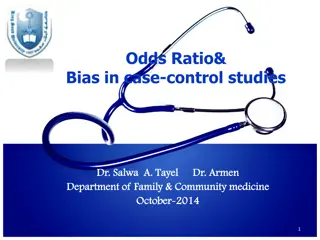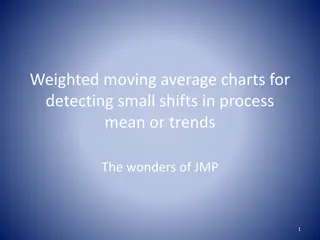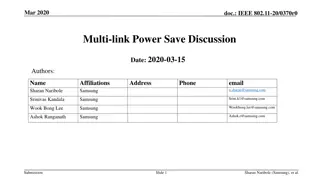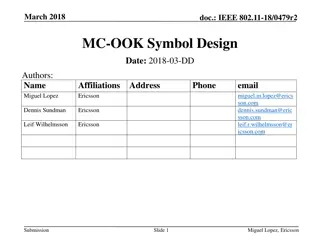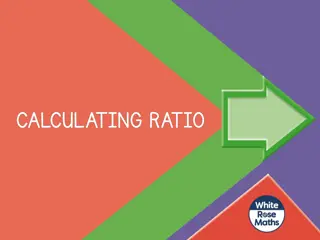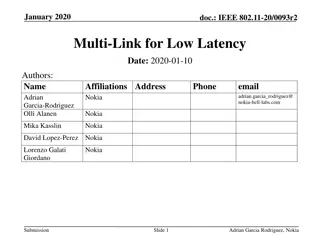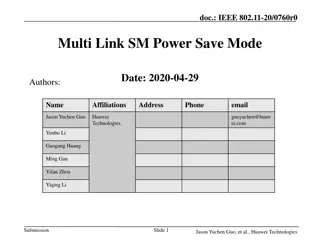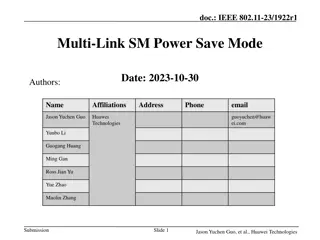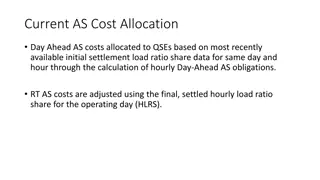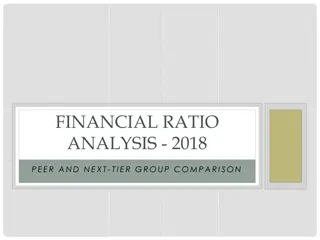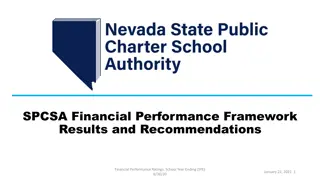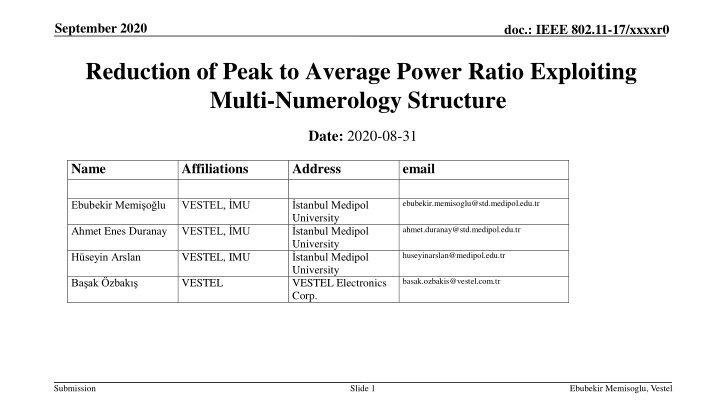
Reducing Peak to Average Power Ratio in Multi-Numerology OFDM Waveforms
Explore a new method for Peak to Average Power Ratio (PAPR) reduction in OFDM waveforms with multi-numerology structures. Learn how scheduling different numerologies can optimize PAPR values, potentially benefiting 5G New Radio and Wi-Fi systems. Discover the advantages of leveraging multi-numerology configurations for efficient PAPR reduction techniques.
Download Presentation

Please find below an Image/Link to download the presentation.
The content on the website is provided AS IS for your information and personal use only. It may not be sold, licensed, or shared on other websites without obtaining consent from the author. If you encounter any issues during the download, it is possible that the publisher has removed the file from their server.
You are allowed to download the files provided on this website for personal or commercial use, subject to the condition that they are used lawfully. All files are the property of their respective owners.
The content on the website is provided AS IS for your information and personal use only. It may not be sold, licensed, or shared on other websites without obtaining consent from the author.
E N D
Presentation Transcript
September 2020 doc.: IEEE 802.11-17/xxxxr0 Reduction of Peak to Average Power Ratio Exploiting Multi-Numerology Structure Date: 2020-08-31 Name Affiliations Address email Ebubekir Memi o lu VESTEL, MU ebubekir.memisoglu@std.medipol.edu.tr stanbul Medipol University stanbul Medipol University stanbul Medipol University VESTEL Electronics Corp. Ahmet Enes Duranay VESTEL, MU ahmet.duranay@std.medipol.edu.tr H seyin Arslan VESTEL, IMU huseyinarslan@medipol.edu.tr Ba ak zbak VESTEL basak.ozbakis@vestel.com.tr Submission Slide 1 Ebubekir Memisoglu, Vestel
September 2020 doc.: IEEE 802.11-17/xxxxr0 Abstract The peak-to-average power ratio (PAPR) is one of the major problem of OFDM-based waveform. OFDM is widely used waveform in wireless local area networks and cellular networks. Although the PAPR problem is well- studied, still this problem is not solved in an efficient manner. To serve wide variety of applications, the multi-numerology OFDM waveform is decided to be used in 5G New Radio, and it has potential to be used in Wi-Fi systems. Although multi-numerology structure provides many advantages, it can be exploited for PAPR reduction. Therefore, the multi-numerology structure is utilized for PAPR reduction. Submission Slide 2 Ebubekir Memisoglu, Vestel
September 2020 doc.: IEEE 802.11-17/xxxxr0 Introduction The PAPR is very critical to increase the spectral efficiency and decrease the hardware cost. There are lots of PAPR reduction techniques for single-numerology OFDM such as clipping&filtering, selective mapping, partial transmit sequence, tone reservation, so on [1]. For multi-numerology OFDM, there is a few techniques in the literature [2], [3]. Besides 5G New Radio, WLAN standardization may also use the multi- numerology concept to serve diverse needs in Wi-Fi 7 and beyond [4]. In this contribution, a new PAPR reduction method is proposed considering multi-numerology structure. Submission Slide 3 Ebubekir Memisoglu, Vestel
September 2020 doc.: IEEE 802.11-17/xxxxr0 System Model Three different numerologies N1, N2, and N3 are considered and two different mixed numerology cases are illustrated as a) and b). Each numerology has different subcarrier spacing, cyclic prefix (CP) and symbol duration. For the generation of multiple numerologies, frequency-time domain transform is deployed separately for each numerology. Then, the signals in time domain of each symbol are summed as aligned. N1 N1 ?1 kHz ?1 kHz N2 N3 ?2 kHz ?3 kHz a) b) Submission Slide 4 Ebubekir Memisoglu, Vestel
September 2020 doc.: IEEE 802.11-17/xxxxr0 A Proposed Approach: Numerology Scheduling In a multi-numerology system, different numerologies are allocated over spectrum with the parameters of subcarrier spacing, power level, and bandwidth. The scheduling of numerologies can be utilized for PAPR reduction. Among all possible scheduling cases, the signal with minimum PAPR value is chosen. Submission Slide 5 Ebubekir Memisoglu, Vestel
September 2020 doc.: IEEE 802.11-17/xxxxr0 Conclusion A PAPR reduction approach has been introduced by exploiting multi- numerology structure. It concludes that numerology scheduling can change dynamic range of time- domain signal. Although one approach is presented, many other opportunities are available to be developed based on multi-numerology structure. Submission Slide 6 Ebubekir Memisoglu, Vestel
September 2020 doc.: IEEE 802.11-17/xxxxr0 References [1] Y. Rahmatallah and S. Mohan, Peak-to-average power ratio reductionin OFDM systems: A survey and taxonomy, IEEE Commun. SurveysTuts., vol. 15, no. 4, pp. 1567 1592, 4th Quart., 2013. [2] S. G kceli, T. Levanen, J. Yli-Kaakinen, T. Riihonen, M. Renfors, andM. Valkama, PAPR reduction with mixed-numerology OFDM, IEEEWireless Commun. Lett., vol. 9, no. 1, pp. 21 25, Jan. 2020. [3] X. Liu, X. Zhang, L. Zhang, P. Xiao, J. Wei, H. Zhang, and V. C. M.Leung, PAPR reduction using iterative clipping/filtering and ADMMapproaches for OFDM-based mixed-numerology systems, IEEE Trans.on Wireless Commun., vol. 19, no. 4, pp. 2586 2600, 2020. [4] Forward Compatible OFDMA, IEEE 802.11-20/0674r3 Submission Slide 7 Ebubekir Memisoglu, Vestel

